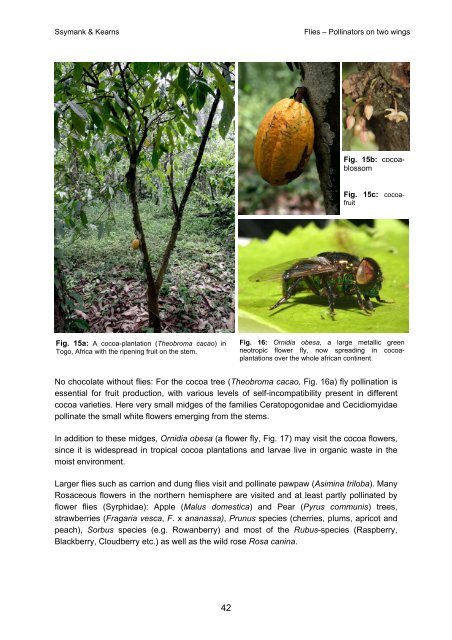Caring for Pollinators - Bundesamt für Naturschutz
Caring for Pollinators - Bundesamt für Naturschutz
Caring for Pollinators - Bundesamt für Naturschutz
You also want an ePaper? Increase the reach of your titles
YUMPU automatically turns print PDFs into web optimized ePapers that Google loves.
Ssymank & Kearns Flies – <strong>Pollinators</strong> on two wings<br />
Fig. 15a: A cocoa-plantation (Theobroma cacao) in<br />
Togo, Africa with the ripening fruit on the stem.<br />
Fig. 15b: cocoablossom<br />
Fig. 15c: cocoafruit<br />
Fig. 16: Ornidia obesa, a large metallic green<br />
neotropic flower fly, now spreading in cocoaplantations<br />
over the whole african continent.<br />
No chocolate without flies: For the cocoa tree (Theobroma cacao, Fig. 16a) fly pollination is<br />
essential <strong>for</strong> fruit production, with various levels of self-incompatibility present in different<br />
cocoa varieties. Here very small midges of the families Ceratopogonidae and Cecidiomyidae<br />
pollinate the small white flowers emerging from the stems.<br />
In addition to these midges, Ornidia obesa (a flower fly, Fig. 17) may visit the cocoa flowers,<br />
since it is widespread in tropical cocoa plantations and larvae<br />
live in organic waste in the<br />
moist environment.<br />
Larger flies such as carrion and dung flies visit and pollinate pawpaw (Asimina triloba). Many<br />
Rosaceous flowers in<br />
the northern hemisphere are visited and at least partly pollinated by<br />
flower flies (Syrphidae): Apple (Malus domestica) and Pear (Pyrus communis) trees,<br />
strawberries (Fragaria vesca, F. x ananassa), Prunus species (cherries, plums, apricot and<br />
peach), Sorbus species (e.g. Rowanberry) and most of the Rubus-species (Raspberry,<br />
Blackberry, Cloudberry etc.) as well as the wild rose Rosa canina.<br />
42

















